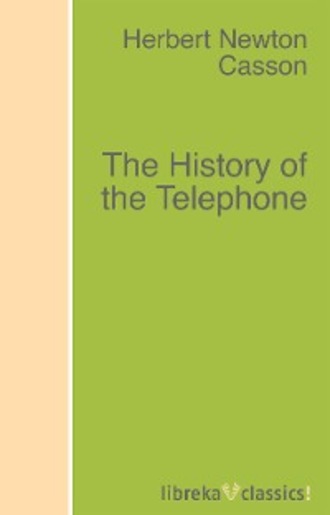
Полная версия
The History of the Telephone
Hubbard first became aware of Bell's inventive efforts one evening when Bell was visiting at his home in Cambridge. Bell was illustrating some of the mysteries of acoustics by the aid of a piano. "Do you know," he said to Hubbard, "that if I sing the note G close to the strings of the piano, that the G-string will answer me?" "Well, what then?" asked Hubbard. "It is a fact of tremendous importance," replied Bell. "It is an evidence that we may some day have a musical telegraph, which will send as many messages simultaneously over one wire as there are notes on that piano."
Later, Bell ventured to confide to Hubbard his wild dream of sending speech over an electric wire, but Hubbard laughed him to scorn. "Now you are talking nonsense," he said. "Such a thing never could be more than a scientific toy. You had better throw that idea out of your mind and go ahead with your musical telegraph, which if it is successful will make you a millionaire."
But the longer Bell toiled at his musical telegraph, the more he dreamed of replacing the telegraph and its cumbrous sign-language by a new machine that would carry, not dots and dashes, but the human voice. "If I can make a deaf-mute talk," he said, "I can make iron talk." For months he wavered between the two ideas. He had no more than the most hazy conception of what this voice-carrying machine would be like. At first he conceived of having a harp at one end of the wire, and a speaking-trumpet at the other, so that the tones of the voice would be reproduced by the strings of the harp.
Then, in the early Summer of 1874, while he was puzzling over this harp apparatus, the dim outline of a new path suddenly glinted in front of him. He had not been forgetful of "Visible Speech" all this while, but had been making experiments with two remarkable machines—the phonautograph and the manometric capsule, by means of which the vibrations of sound were made plainly visible. If these could be im-proved, he thought, then the deaf might be taught to speak by SIGHT—by learning an alphabet of vibrations. He mentioned these experiments to a Boston friend, Dr. Clarence J. Blake, and he, being a surgeon and an aurist, naturally said, "Why don't you use a REAL EAR?"
Such an idea never had, and probably never could have, occurred to Bell; but he accepted it with eagerness. Dr. Blake cut an ear from a dead man's head, together with the ear-drum and the associated bones. Bell took this fragment of a skull and arranged it so that a straw touched the ear-drum at one end and a piece of moving smoked glass at the other. Thus, when Bell spoke loudly into the ear, the vibrations of the drum made tiny markings upon the glass.
It was one of the most extraordinary incidents in the whole history of the telephone. To an uninitiated onlooker, nothing could have been more ghastly or absurd. How could any one have interpreted the gruesome joy of this young professor with the pale face and the black eyes, who stood earnestly singing, whispering, and shouting into a dead man's ear? What sort of a wizard must he be, or ghoul, or madman? And in Salem, too, the home of the witchcraft superstition! Certainly it would not have gone well with Bell had he lived two centuries earlier and been caught at such black magic.
What had this dead man's ear to do with the invention of the telephone? Much. Bell noticed how small and thin was the ear-drum, and yet how effectively it could send thrills and vibrations through heavy bones. "If this tiny disc can vibrate a bone," he thought, "then an iron disc might vibrate an iron rod, or at least, an iron wire." In a flash the conception of a membrane telephone was pictured in his mind. He saw in imagination two iron discs, or ear-drums, far apart and connected by an electrified wire, catching the vibrations of sound at one end, and reproducing them at the other. At last he was on the right path, and had a theoretical knowledge of what a speaking telephone ought to be. What remained to be done was to construct such a machine and find out how the electric current could best be brought into harness.



